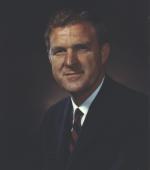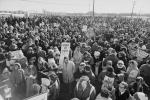![header=[Marker Text] body=[Efforts to organize public workers in PA resulted in Acts 111 in 1968 and 195 in 1970. Tens of thousands of public employees joined unions. The movement to unionize public workers began in the 1930s, was legislatively restricted in 1947, and given partial recognition in 1957.] sign](http://explorepahistory.com/kora/files/1/10/1-A-C0-139-ExplorePAHistory-a0m9h9-a_450.jpg)
Mouse over for marker text
Name:
Public Sector Unionism
Region:
Hershey/Gettysburg/Dutch Country Region
County:
Dauphin
Marker Location:
State St., near 3rd, Harrisburg
Dedication Date:
September 9, 2005
Behind the Marker
Formed in 1932, the American Federation of State, County, and Municipal Employees (AFSCME) won a number of efforts to improve working conditions and wages for public sector workers during the 1930s. Despite a common view that public sector unions were marginal to the rise of labor's collective bargaining powers, they have been central to protecting and furthering the lives of millions of working Americans since the late 1930s.
Government employees' organizing efforts were aided by three important developments following World War II. The first was passage of the Public Employment Relations Act (PERA) in 1947, which permitted government workers to organize for the first time into unions and engage in collective bargaining.
Prior to PERA's passage, it was illegal for government entities to recognize or bargain with public-sector unions representing teachers, cab drivers, sanitation crews, city and county workers, and other professional groups. Still, it was not easy for workers to gain union recognition under PERA, as the courts frequently barred public- sector workers from striking, bargaining freely for decent contracts, and arbitrating disputes with employers.
Since the 1920s, the courts had frequently equated the union membership of government employees with disloyalty and had condemned strikes as a waste of taxpayer resources. Even when PERA granted workers the right to bargain under union guidelines, employers-including mayors, school boards, and heads of government agencies-imposed rules that stifled public sector unions by claiming that "good government" required "loyal civil service" from its workers without public sector unions. Still, the new law of 1947 permitted unions to step forward with challenges to these obstacles.
The second important development was a restructuring of AFSCME's District 33 and the appointment of Gerald McEntee as an organizer and negotiator in 1956. McEntee went on to lead the historic drive that brought union rights to over 75,000 state workers during the 1960s. Until then, public sector employment had been connected to political patronage.
McEntee spearheaded one of the largest organizing drives in American labor history. Tens of thousands of Pennsylvania's state employees, and thousands of municipal, county, township, borough, and school district employees in public and private non-profit jobs were brought into the city's public sector unions during the 1960s and 1970s.
The third important development was state legislation to expand union rights. In the 1960s, Pennsylvania public sector unions went on strike in record numbers for better wages: thirteen times in 1968 and twenty-six times in 1969. The 1968 strikes included two by teachers-one in Scranton, and an eleven-day walkout by 1,200 of the Pittsburgh School District's 3,600 teachers to force the school board to recognize the union. Police and firefighters had already won a limited right to collective bargaining, but not to strike, but passage of Act 111 in 1968 required a change in the state constitution to accommodate the right to strike.
A new proposed law in 1969 would cover all public agencies and their right to collectively bargain, although the new law also limited strikes to extreme cases of negotiating breakdowns.
By the 1980s, public sector unionism had become the most vibrant area of the American labor movement, in the midst of declining membership in traditional labor unions in the private sector. By the end of the 1990s, public sector union membership had risen to more than six million in the country. Public sector workers constituted less than 16 percent of all American workers, but they made up 43 percent of all union members in the country.
By 2000, public sector unions for teachers, maintenance, construction-related, and government service workers had dramatically improved working conditions and wages, and extended protection for health and personal welfare to thousands upon thousands of Pennsylvania workers. They also proved to be a strong shield against arbitrary layoffs, and introduced innovative ways to settle labor disputes, including compulsory arbitration rather than the customary strikes and lockouts found in such private sector workplaces such as railroads, mining, or maritime trades.
Government employees' organizing efforts were aided by three important developments following World War II. The first was passage of the Public Employment Relations Act (PERA) in 1947, which permitted government workers to organize for the first time into unions and engage in collective bargaining.
Prior to PERA's passage, it was illegal for government entities to recognize or bargain with public-sector unions representing teachers, cab drivers, sanitation crews, city and county workers, and other professional groups. Still, it was not easy for workers to gain union recognition under PERA, as the courts frequently barred public- sector workers from striking, bargaining freely for decent contracts, and arbitrating disputes with employers.
Since the 1920s, the courts had frequently equated the union membership of government employees with disloyalty and had condemned strikes as a waste of taxpayer resources. Even when PERA granted workers the right to bargain under union guidelines, employers-including mayors, school boards, and heads of government agencies-imposed rules that stifled public sector unions by claiming that "good government" required "loyal civil service" from its workers without public sector unions. Still, the new law of 1947 permitted unions to step forward with challenges to these obstacles.
The second important development was a restructuring of AFSCME's District 33 and the appointment of Gerald McEntee as an organizer and negotiator in 1956. McEntee went on to lead the historic drive that brought union rights to over 75,000 state workers during the 1960s. Until then, public sector employment had been connected to political patronage.
McEntee spearheaded one of the largest organizing drives in American labor history. Tens of thousands of Pennsylvania's state employees, and thousands of municipal, county, township, borough, and school district employees in public and private non-profit jobs were brought into the city's public sector unions during the 1960s and 1970s.
The third important development was state legislation to expand union rights. In the 1960s, Pennsylvania public sector unions went on strike in record numbers for better wages: thirteen times in 1968 and twenty-six times in 1969. The 1968 strikes included two by teachers-one in Scranton, and an eleven-day walkout by 1,200 of the Pittsburgh School District's 3,600 teachers to force the school board to recognize the union. Police and firefighters had already won a limited right to collective bargaining, but not to strike, but passage of Act 111 in 1968 required a change in the state constitution to accommodate the right to strike.
A new proposed law in 1969 would cover all public agencies and their right to collectively bargain, although the new law also limited strikes to extreme cases of negotiating breakdowns.
By the 1980s, public sector unionism had become the most vibrant area of the American labor movement, in the midst of declining membership in traditional labor unions in the private sector. By the end of the 1990s, public sector union membership had risen to more than six million in the country. Public sector workers constituted less than 16 percent of all American workers, but they made up 43 percent of all union members in the country.
By 2000, public sector unions for teachers, maintenance, construction-related, and government service workers had dramatically improved working conditions and wages, and extended protection for health and personal welfare to thousands upon thousands of Pennsylvania workers. They also proved to be a strong shield against arbitrary layoffs, and introduced innovative ways to settle labor disputes, including compulsory arbitration rather than the customary strikes and lockouts found in such private sector workplaces such as railroads, mining, or maritime trades.
Beyond the Marker








